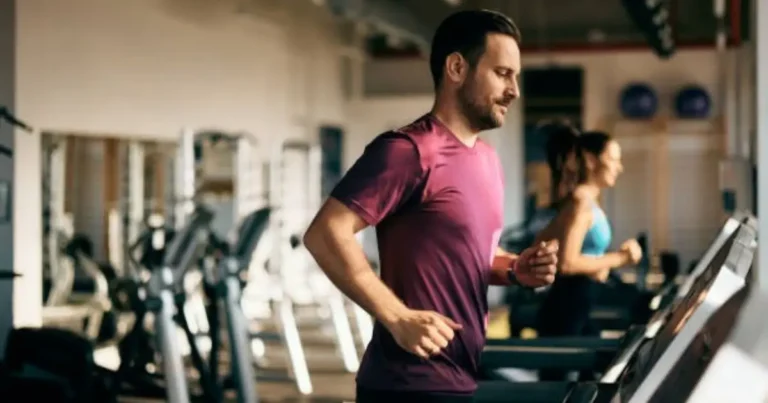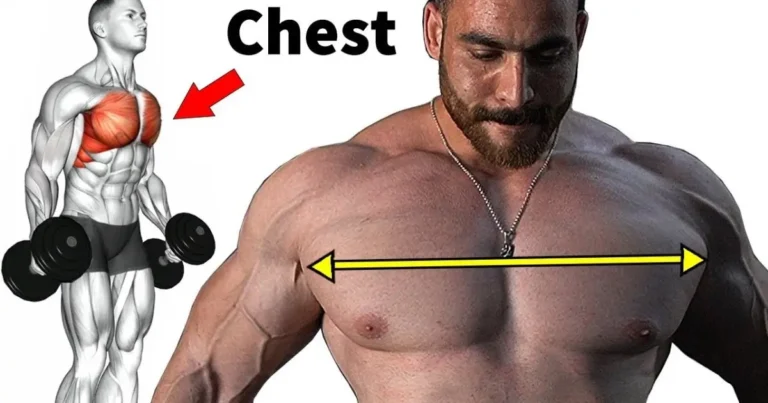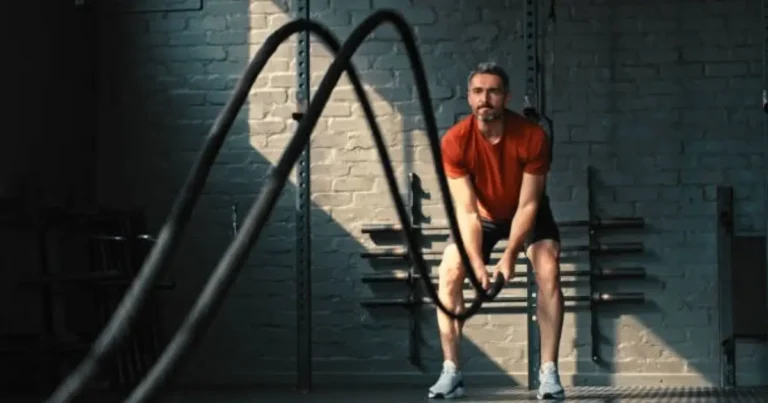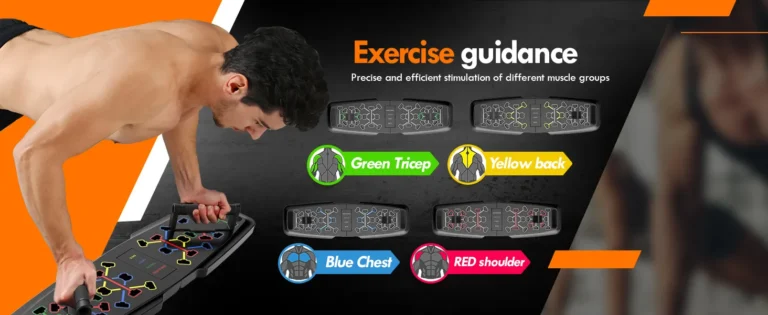Best Abs Workout Equipment for a Stronger Core at Home or Gym
Are you looking to strengthen your core and achieve those coveted six-pack abs? Having the right abs workout equipment can make all the difference in your fitness journey. Whether you’re exercising at home or hitting the gym, specific tools designed for abdominal training can help you target your core muscles more effectively and see results faster.
In this comprehensive guide, we’ll explore the best abs workout equipment options available today, from versatile ab rollers to resistance bands and specialized machines. You’ll discover how each piece of equipment works, the benefits they offer, and which ones might be right for your specific fitness level and goals.
Table of Contents
The Ultimate Guide to Ab Rollers

What is an ab roller?
An ab roller (sometimes called an ab wheel) is a simple yet incredibly effective piece of abs workout equipment consisting of a wheel with handles on either side. When used properly, this humble device engages multiple muscle groups simultaneously, with particular emphasis on your core.
Benefits of using an ab roller
Ab rollers offer several advantages over traditional core exercises:
- Total core engagement: Activates not just your abs but your entire core, including deep stabilizing muscles
- Upper body workout: Engages shoulders, chest, and arms simultaneously
- Space-efficient: Small, portable design makes it perfect for home workouts
- Cost-effective: Affordable compared to larger equipment
- Scalable difficulty: Can be modified for beginners or advanced users
Different types of ab rollers
Not all ab rollers are created equal. Here are the main variations you’ll encounter:
- Standard single wheel – The classic design with one wheel and two handles
- Dual wheel – Provides more stability, ideal for beginners
- Spring-loaded – Features a resistance spring to assist with the rollback phase
- Multi-wheel stability systems – Wide base with multiple wheels for maximum stability
- Ergonomic handles – Designed to reduce wrist strain during exercises
How to choose the right ab roller
When selecting an ab roller, consider these factors:
- Stability needs: Beginners may benefit from multi-wheel designs
- Handle comfort: Look for ergonomic grips, especially if you have wrist issues
- Build quality: Ensure the wheel can support your weight without wobbling
- Portability: Consider size and weight if you plan to travel with it
- Return assistance: Spring-loaded models help with the challenging return phase
Top 5 ab rollers of 2025
Review of Ab Roller 1: Perfect Fitness Ab Carver Pro
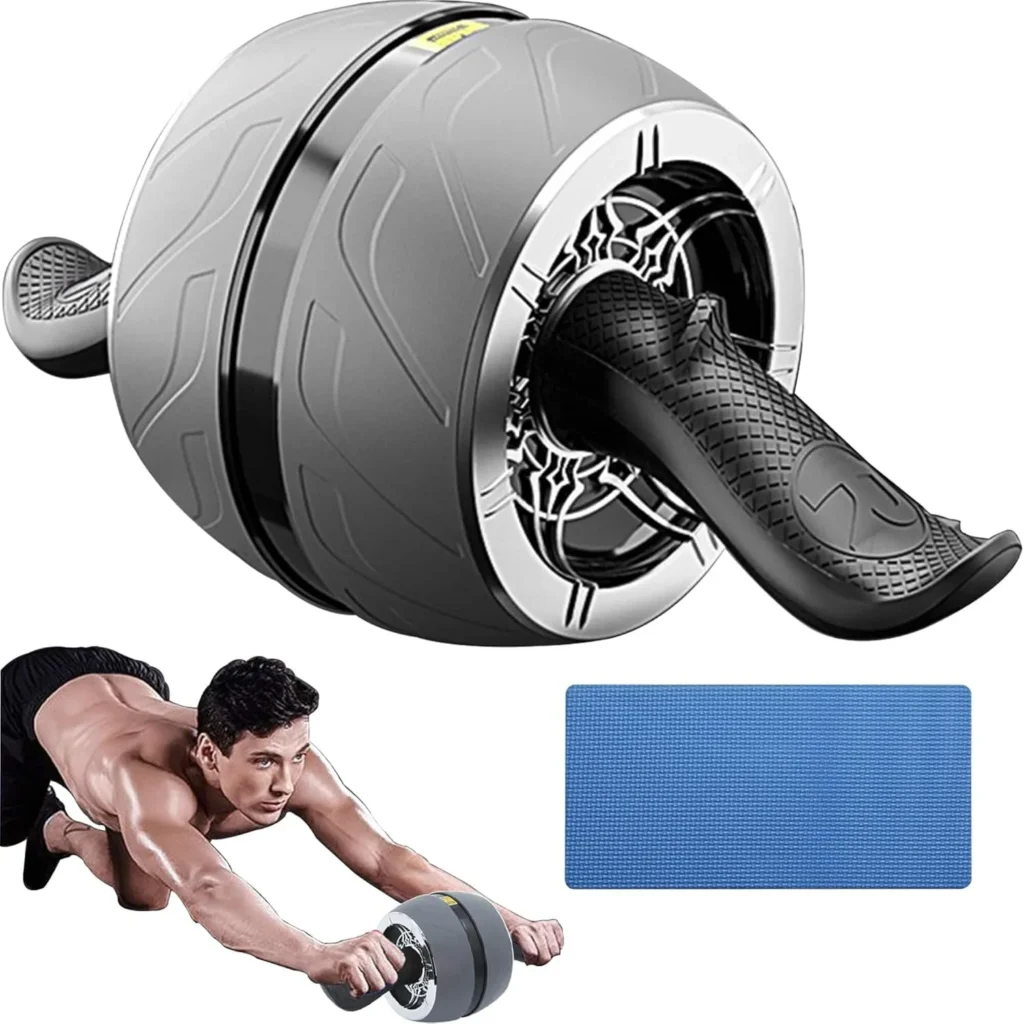
The Perfect Fitness Ab Carver Pro stands out with its ultra-wide wheel and built-in spring mechanism. The carbon steel spring provides resistance when rolling out and assistance when rolling back, making it suitable for users of all fitness levels.
Pros:
- Kinetic engine with carbon steel spring for controlled movement
- Wide, angled wheel for multi-directional rolling
- Ergonomic hand grips to reduce wrist strain
- Includes knee pad and training guide
Cons:
- Slightly bulkier than basic models
- Higher price point than standard rollers
Review of Ab Roller 2: SKLZ Core Wheels
The SKLZ Core Wheels offer a unique dual-wheel design that allows for independent movement of each arm. This creates instability that forces your core to work harder for stabilization.
Pros:
- Independent wheels for increased muscle activation
- Versatile for various exercise variations
- Compact and portable design
- Durable construction
Cons:
- Steeper learning curve for beginners
- May be challenging for those with shoulder issues
Review of Ab Roller 3: Iron Gym Speed Abs
The Iron Gym Speed Abs roller features a wide wheel design that provides excellent stability while remaining lightweight and portable. Its ergonomic handles make it comfortable for extended use.
Pros:
- Wide wheel for enhanced stability
- Non-slip rubber wheel for various surfaces
- Comfortable foam grip handles
- Budget-friendly option
Cons:
- No spring assistance for rollback
- Less durable than premium models
Review of Ab Roller 4: Lifeline Power Wheel
The Lifeline Power Wheel takes ab rolling to the next level with foot straps that allow for a wider variety of exercises. This versatility makes it a favorite among fitness enthusiasts looking to target their core from multiple angles.
Pros:
- Foot pedals for expanded exercise variety
- Large wheel for better stability
- Sturdy construction for heavier users
- Allows for pike, hamstring, and plank variations
Cons:
- Higher price point
- Larger size requires more storage space
Review of Ab Roller 5: Elite Sportz Ab Wheel
The Elite Sportz Ab Wheel features a dual-wheel design that offers excellent stability for beginners while still providing an effective workout for more advanced users.
Pros:
- Dual wheels for improved balance
- Non-slip rubber wheels
- Comfortable foam handles
- Comes with knee pad
- Budget-friendly
Cons:
- Basic design without advanced features
- Less challenging for very advanced users
Where to buy ab rollers
Ab rollers are widely available at:
- Sporting goods stores like Dick’s Sporting Goods or Academy Sports
- Fitness equipment retailers such as Rogue Fitness or Rep Fitness
- Online marketplaces including Amazon, Walmart.com, and Target.com
- Specialty fitness websites
When purchasing, consider checking reviews for durability and warranty information, especially for higher-end models.
Ab Crunch Machines: A Comprehensive Guide
What is an ab crunch machine?

An ab crunch machine is a specialized piece of abs workout equipment designed to isolate and target the abdominal muscles through a guided range of motion. These machines typically feature padded seats, resistance mechanisms, and handles or pads to help users perform crunch movements with proper form.
Benefits of using an ab crunch machine
Ab crunch machines offer several advantages:
- Guided movement: Helps maintain proper form throughout the exercise
- Adjustable resistance: Allows for progressive overload as strength improves
- Reduced neck strain: Many designs minimize strain on the neck and upper back
- Isolation: Effectively targets specific abdominal muscles
- Accessibility: Often suitable for beginners or those with limited mobility
Different types of ab crunch machines
The main variations include:
- Seated ab crunch machines – User sits upright with pads pressing against the chest
- Decline ab benches – Angled benches with foot anchors for traditional crunches
- Cable crunch stations – Use cable resistance for kneeling or standing ab work
- Multi-function machines – Part of larger home gym systems with ab attachments
How to choose the right ab crunch machine
Consider these factors when selecting an ab crunch machine:
- Available space: Measure your workout area before purchasing
- Resistance type: Weight stacks, bands, or plates each have different benefits
- Adjustability: Look for customizable settings to fit your body size
- Build quality: Check weight capacity and durability
- Comfort: Ensure padding is adequate for extended use
Top 3 ab crunch machines of 2025
Review of Ab Crunch Machine 1: XMark Fitness 12 Position Adjustable Ab Bench
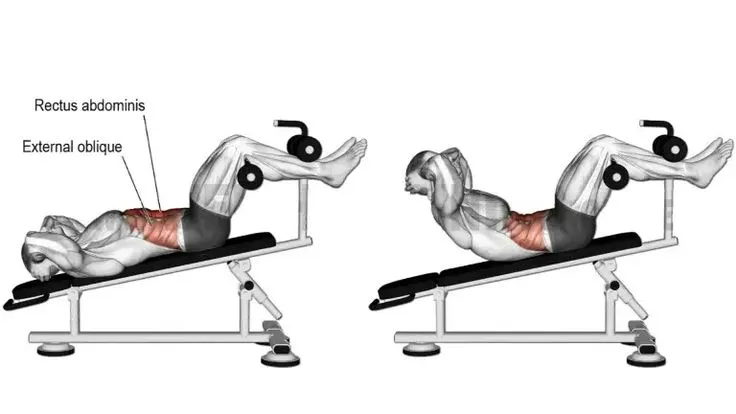
This versatile decline bench offers 12 adjustment positions to vary workout intensity and targets different areas of the abdominals.
Pros:
- Multiple decline positions for workout variety
- Ergonomic roller pads for leg comfort
- Support handle for easy mounting/dismounting
- Sturdy 14-gauge steel frame
Cons:
- Takes up significant floor space
- Assembly required
Review of Ab Crunch Machine 2: Marcy Adjustable Hyperextension Roman Chair
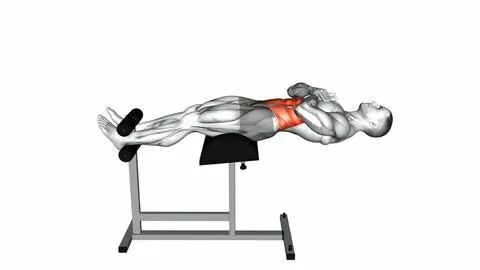
This dual-function machine allows for both ab crunches and back extensions, making it excellent for total core development.
Pros:
- Versatile for both abdominal and lower back exercises
- Adjustable for various user heights
- Padded handles and cushions for comfort
- Compact footprint compared to other machines
Cons:
- Less targeted than dedicated ab machines
- Limited resistance options
Review of Ab Crunch Machine 3: Body-Solid GAB300 Semi-Recumbent Ab Bench
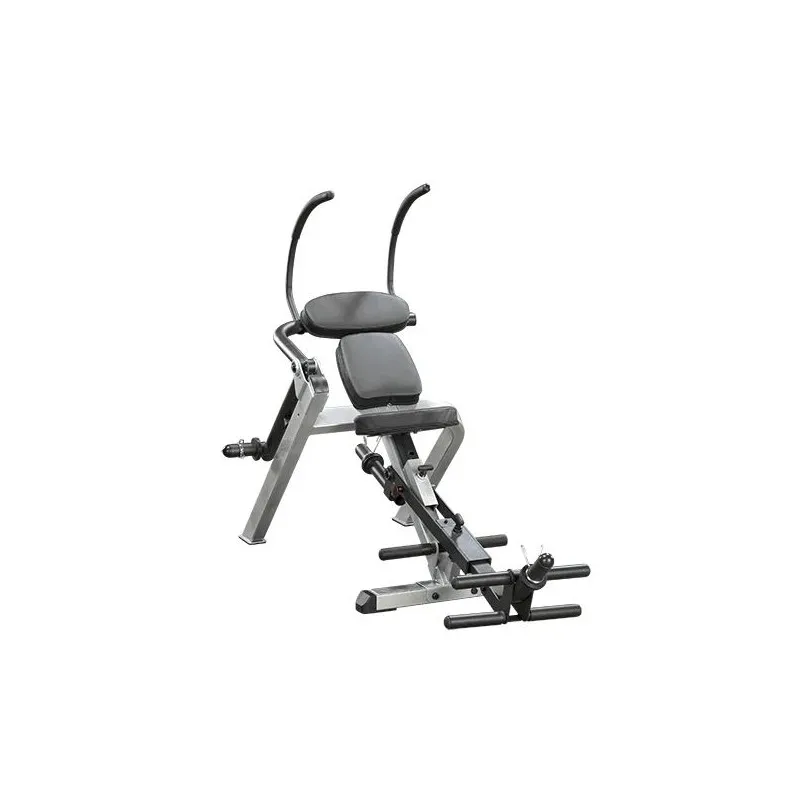
This commercial-grade ab machine features a semi-recumbent position that reduces back strain while providing effective ab activation.
Pros:
- Ergonomic design reduces lower back stress
- Adjustable resistance settings
- Heavy-duty construction for durability
- Comfortable padding
Cons:
- Premium price point
- Substantial size requires dedicated space
Are Ab Crunch Machines Effective? Comparing to other methods
Ab crunch machines can be highly effective when used properly, but their effectiveness compared to other abs workout equipment depends on several factors:
| Ab Exercise Method | Core Activation | Functional Carryover | Cost | Space Required |
| Ab Crunch Machines | High (targeted) | Moderate | High | Large |
| Ab Rollers | Very High | High | Low | Minimal |
| Resistance Bands | Moderate-High | High | Low | Minimal |
| Bodyweight Exercises | Moderate-High | Very High | None | Minimal |
Ab crunch machines excel at isolation work and can be beneficial for beginners learning proper form. However, for functional core strength, they should be part of a comprehensive routine that includes other exercises that challenge stability and rotational movements.
Resistance Bands for Abs: A Versatile and Affordable Option
Benefits of using resistance bands for ab workouts
Resistance bands have become increasingly popular as abs workout equipment due to their numerous advantages:
- Progressive resistance: Bands provide increasing resistance throughout the movement
- Versatility: Can be used for dozens of different ab exercises
- Portability: Lightweight and easy to take anywhere
- Affordability: Excellent value compared to larger equipment
- Joint-friendly: Lower impact than many weighted exercises
- Adaptability: Suitable for all fitness levels
Types of resistance bands for ab exercises
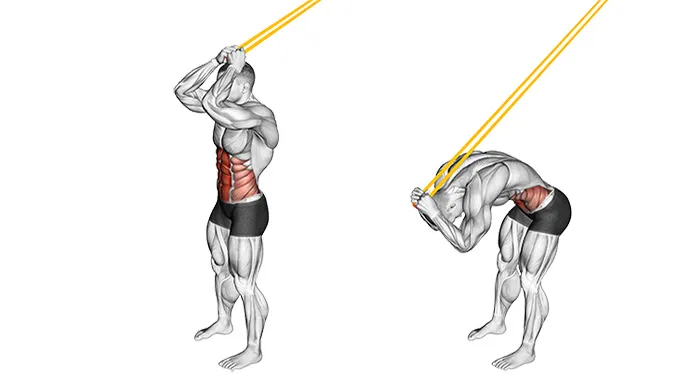
Several types of resistance bands can be used effectively for ab training:
- Loop bands – Continuous loops ideal for anti-rotation exercises
- Tube bands with handles – Great for rotational movements and woodchoppers
- Flat therapy bands – Versatile for various resistance levels
- Figure 8 bands – Shaped for specific movement patterns
- Mini bands – Small loops perfect for adding resistance to floor exercises
Resistance band ab workout routine
Here’s a simple yet effective resistance band ab routine:
- Banded Standing Oblique Twists: 3 sets of 15 reps each side
- Banded Pallof Press: 3 sets of 12 reps each side
- Resistance Band Russian Twists: 3 sets of 20 reps
- Banded Kneeling Crunches: 3 sets of 15 reps
- Anti-Rotation Hold: 3 sets of 30-second holds each side
Perform this circuit 2-3 times per week for noticeable core strength improvements.
Best resistance bands for ab workouts
Review of Resistance Band Set 1: Whatafit Resistance Bands Set

This comprehensive set includes five bands of different resistance levels, handles, door anchor, and ankle straps, making it perfect for a complete abs workout system.
Pros:
- Multiple resistance levels (10-50 lbs)
- Includes accessories for versatile workouts
- Durable natural latex construction
- Portable carrying case included
Cons:
- Handles may not be comfortable for everyone
- Door anchor requires specific door types
Review of Resistance Band Set 2: Fit Simplify Resistance Loop Exercise Bands
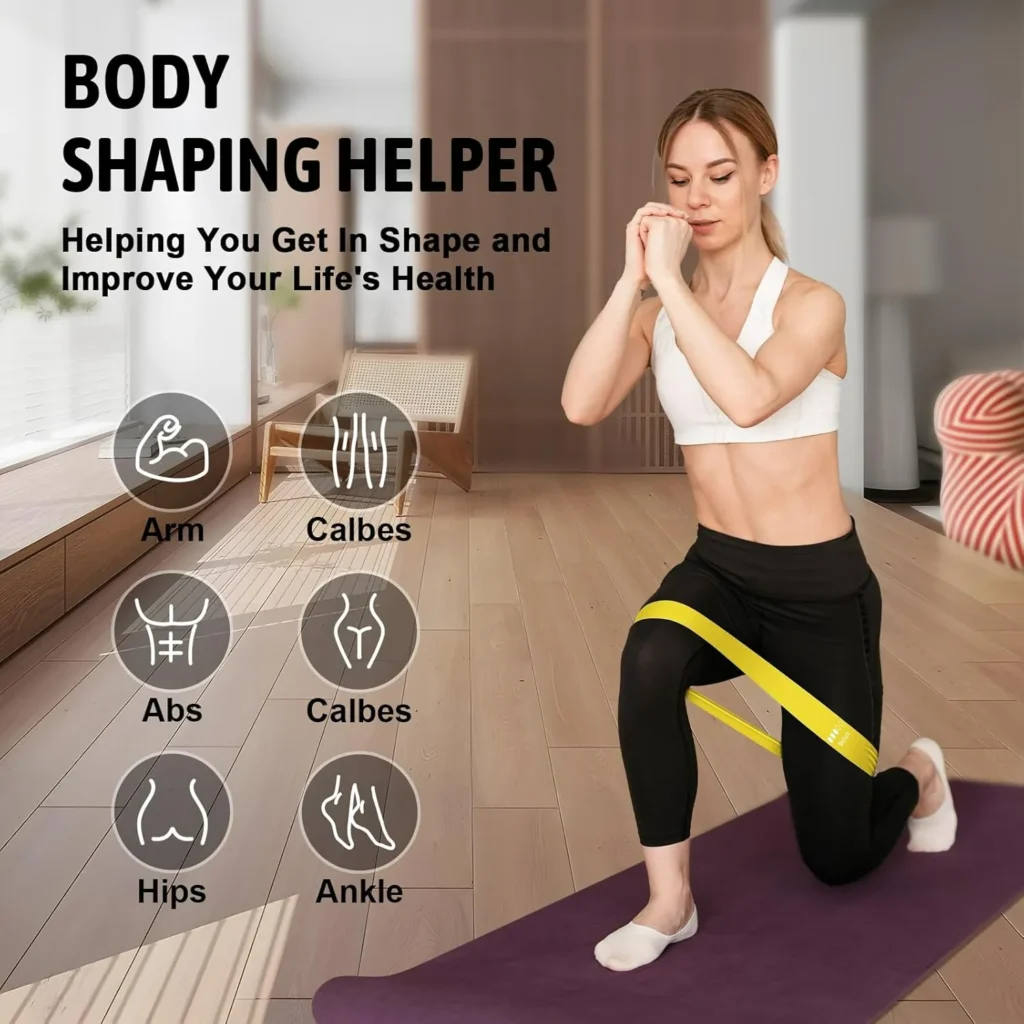
These flat loop bands come in five resistance levels and are particularly effective for floor-based ab exercises.
Pros:
- Color-coded for easy resistance identification
- Natural latex for durability and smooth resistance
- Lightweight and ultra-portable
- Instruction guide and carrying bag included
- Very affordable price point
Cons:
- May roll up during certain exercises
- Can lose elasticity over time with heavy use
Tips for choosing the right resistance bands
When selecting resistance bands for abs workout equipment, consider:
- Resistance level: Beginners should start with lighter resistance
- Material quality: Look for natural latex for durability
- Band type: Choose based on the exercises you plan to perform
- Accessories: Consider whether you need handles, anchors, or other attachments
- Safety features: Check for anti-snap designs and quality manufacturing
The Ultimate Ab Roller Workout for Beginners
Safety precautions
Before beginning any ab roller workout, take these safety measures:
- Check equipment: Ensure your ab roller is in good condition with no cracks
- Clear space: Work on a flat, clear surface with enough room to extend fully
- Warm up: Always warm up your core and shoulders before using an ab roller
- Use padding: Work on an exercise mat to protect your knees
- Know your limits: Start with modified versions if you’re a true beginner
Proper form
Correct ab roller form is essential for effectiveness and safety:
- Begin on your knees with the roller directly beneath your shoulders
- Grip the handles with hands shoulder-width apart
- Engage your core by drawing your navel toward your spine
- Keep your back flat (not arched or rounded)
- Roll forward using core control, not momentum
- Extend only as far as you can maintain proper form
- Use core strength to pull yourself back to the starting position
Beginner-friendly ab roller exercises
Start with these modifications to build strength:
- Wall Rollouts: Roll toward a wall instead of the floor
- Limited Range Rollouts: Roll out only partially before returning
- Incline Rollouts: Use an elevated surface to decrease difficulty
- Assisted Rollouts: Use a resistance band for help returning to start position
Workout routine
Try this beginner ab roller routine:
Week 1-2:
- Wall rollouts: 3 sets of 8-10 reps

- Rest 60 seconds between sets
- Perform 2-3 times per week
Week 3-4:
- Limited range rollouts: 3 sets of 8-10 reps
- Rest 45 seconds between sets
- Perform 2-3 times per week
Week 5-6:
- Standard kneeling rollouts: 3 sets of 6-8 reps

- Rest 45 seconds between sets
- Perform 2-3 times per week
Tips for progression
To advance with your abs workout equipment:
- Add one rep per session before increasing range
- Focus on slower, more controlled movements
- Gradually decrease rest periods as strength improves
- Only progress when you can maintain perfect form
- Consider tracking your progress with photos or measurements
Advanced Ab Roller Exercises for a Killer Core
Prerequisites
Before attempting advanced ab roller exercises, ensure you can:
- Perform 15+ standard kneeling rollouts with perfect form
- Hold a plank position for at least 60 seconds
- Complete basic movements without lower back pain
- Maintain proper shoulder stability throughout movements
Advanced ab roller exercises
Take your core training to the next level with:
- Standing Ab Rollouts: The ultimate progression, performed from a standing position
- Angular Rollouts: Roll at various angles to target obliques
- Single-Arm Rollouts: Roll using one arm for intense anti-rotation challenge
- Elevated Feet Rollouts: Place feet on a bench to increase difficulty
- Ab Roller Pike: Combine rollout with a pike movement
Workout routine
This advanced routine will challenge even well-conditioned core muscles:
Workout A:
- Standard rollouts: 3 sets of 15 reps
- Angular rollouts: 3 sets of 10 reps each side
- Elevated feet rollouts: 3 sets of 8 reps
Workout B:
- Long-hold rollouts (pause at extension): 3 sets of 8 reps
- Single-arm supported rollouts: 3 sets of 6 each side
- Standing partial rollouts: 3 sets of 5 reps
Alternate between Workout A and B, training abs 2-3 times weekly.
Tips for maximizing results
To get the most from advanced ab roller work:
- Focus on tension throughout the entire movement
- Incorporate breathing techniques (exhale during effort)
- Maintain full-body tension during exercises
- Add weighted vest for additional challenge
- Combine with complementary core exercises for balanced development
15-Minute Ab Workout Using Only Resistance Bands
Warm-up
Begin with this quick warm-up:
- Marching in place: 45 seconds
- Torso rotations: 30 seconds
- Gentle side bends: 30 seconds
- Band pulls apart: 30 seconds
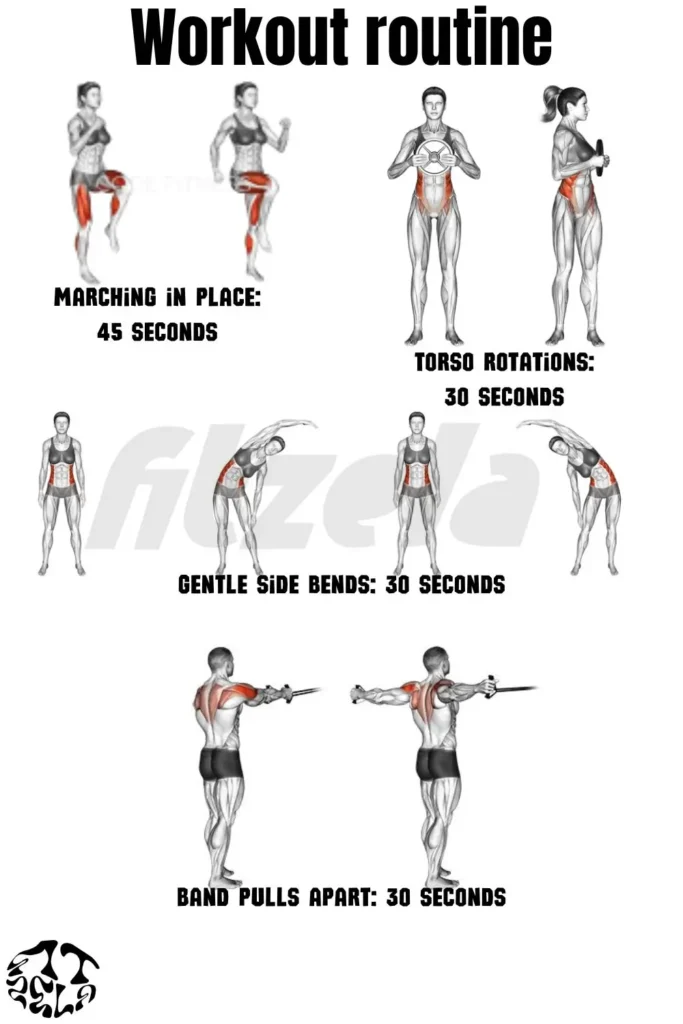
Resistance band exercises
Complete this circuit with minimal rest between exercises:
- Banded Standing Crunches:
- Anchor band under feet, hold ends at shoulders
- Crunch down while exhaling forcefully
- 45 seconds work, 15 seconds rest
- Banded Russian Twists:
- Seated with band around feet, hold ends together
- Rotate torso side to side with control
- 45 seconds work, 15 seconds rest
- Resistance Band Woodchoppers:
- Anchor band low, pull diagonally upward across body
- Control the return motion
- 45 seconds each side, 15 seconds rest
- Banded Mountain Climbers:
- Loop band around feet, plank position
- Alternate bringing knees to chest
- 45 seconds work, 15 seconds rest
- Pallof Press:
- Anchor band to side, hold at chest height
- Press band away while resisting rotation
- 45 seconds each side
Repeat the entire circuit twice for a complete 15-minute workout.
Cool-down
Finish with:
- Gentle torso stretches: 30 seconds
- Child’s pose: 30 seconds
- Cat-cow stretches: 30 seconds
- Deep breathing: 30 seconds
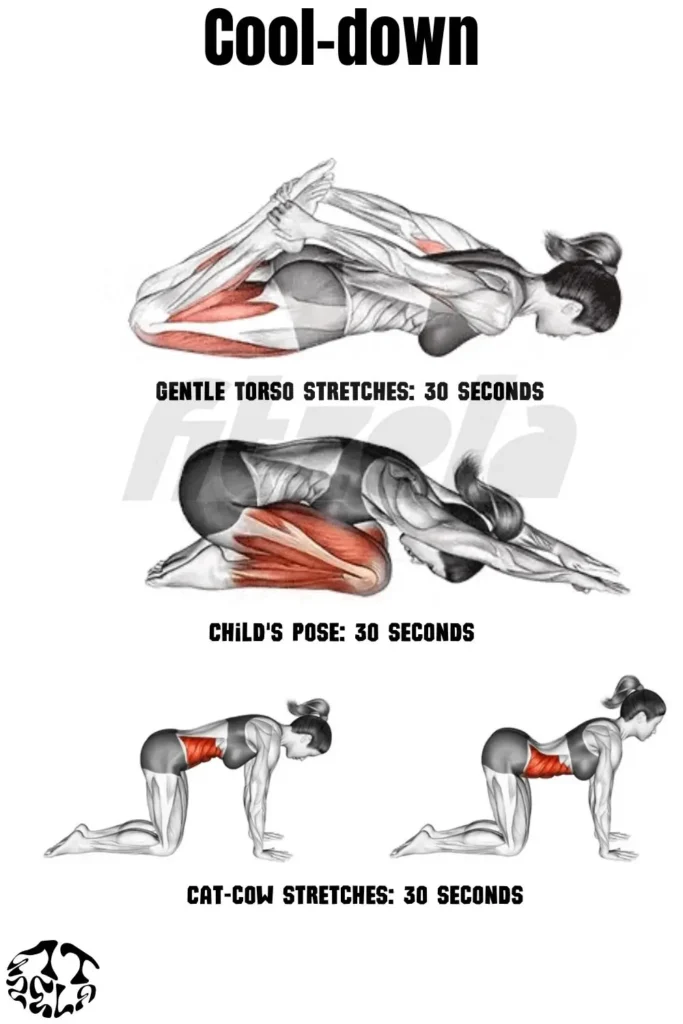
Workout variations
Modify this routine by:
- Increasing work periods to 60 seconds for greater endurance
- Using heavier bands for increased resistance
- Adding isometric holds at points of maximum tension
- Performing exercises more slowly to increase time under tension
- Creating supersets by pairing complementary movements
The Benefits of a Strong Core: More Than Just a Six-Pack
Improved posture
A strong core provides essential support for proper alignment:
- Helps maintain natural spinal curvature
- Reduces forward head posture
- Prevents excessive lumbar curve
- Supports proper rib cage position
- Enables better shoulder positioning
These improvements can make you appear taller, more confident, and reduce the appearance of a protruding abdomen.
Reduced back pain
Core strength directly impacts back health:
“About 80% of adults experience low back pain at some point in their lifetimes. It is the most common cause of job-related disability.” – National Institute of Neurological Disorders and Stroke
Strong abdominals provide critical support to the spine, reducing pressure on vertebral discs and preventing excessive movement that can lead to pain. Regular use of abs workout equipment like resistance bands can strengthen these supportive muscles.
Increased athletic performance
Your core serves as a power transfer center:
- Connects upper and lower body movements
- Provides rotational force for throwing, swinging, and kicking
- Stabilizes body during rapid direction changes
- Enables more powerful running strides
- Improves balance during dynamic movements
Athletes across all sports prioritize core training for these performance-enhancing benefits.
Improved balance and stability
Core strength contributes significantly to everyday functional stability:
- Reduces fall risk, especially in older adults
- Improves stability during single-leg activities
- Enhances proprioception (positional awareness)
- Provides a solid base for lifting and carrying objects
- Enables better control during challenging movements
Choosing the Right Ab Workout Equipment for Your Fitness Level
Beginner
If you’re new to core training:
- Start with: Resistance bands, stability ball
- Focus on: Learning proper engagement and basic movements
- Recommended equipment: Light resistance bands, entry-level ab roller with dual wheels
- Frequency: 2-3 core sessions per week
- Duration: 10-15 minutes per session
Intermediate
For those with some core training experience:
- Start with: Standard ab rollers, suspended bodyweight trainers
- Focus on: Increasing endurance and strength
- Recommended equipment: Quality ab roller, resistance bands with multiple tension levels
- Frequency: 3-4 core sessions per week
- Duration: 15-20 minutes per session
Advanced
For fitness enthusiasts with strong core fundamentals:
- Start with: Advanced ab roller variations, weight-added exercises
- Focus on: Maximum muscle recruitment and progressive overload
- Recommended equipment: Professional-grade ab roller, heavy resistance bands, weighted ab equipment
- Frequency: 3-5 core sessions per week
- Duration: 20-30 minutes per session
Considerations for people with back pain
If you experience back discomfort:
- Consult first: Speak with a healthcare provider before beginning
- Start with: Gentle resistance band exercises with limited range
- Focus on: Stability rather than mobility initially
- Recommended equipment: Stability ball, light resistance bands
- Avoid: Full-range ab roller movements until core is stronger
- Consider: Working with a physical therapist to develop a personalized program
Common Mistakes to Avoid When Using Ab Workout Equipment
Using improper form
Form issues can reduce effectiveness and increase injury risk:
- Ab Roller Mistakes:
- Sagging or arched back
- Rolling too far too soon
- Using shoulders instead of core
- Holding breath during exertion
- Resistance Band Mistakes:
- Insufficient tension in the band
- Relying on momentum rather than control
- Improper band anchoring
- Incorrect body positioning
- Ab Machine Mistakes:
- Pulling with neck instead of engaging abs
- Using excessive weight
- Incomplete range of motion
- Rapid, uncontrolled movements
Overdoing it
Excessive core training can be counterproductive:
- Training abs daily without recovery
- Performing high-volume, long-duration sessions
- Focusing exclusively on one type of movement
- Progressing too quickly to advanced variations
- Ignoring signs of fatigue or strain
Remember that abs, like all muscles, require adequate recovery to grow stronger.
Not engaging the core
Common engagement problems include:
- Failing to activate core before movement begins
- Using hip flexors instead of abdominals
- Not maintaining tension throughout exercises
- Forgetting to breathe properly during movements
- Inability to recognize proper muscle activation
Learning proper core engagement may require practice and occasionally working with a qualified fitness professional.
Ignoring warning signs
Know when to modify or stop:
- Sharp pain (versus muscle fatigue)
- Persistent lower back discomfort
- Neck strain during exercises
- Inability to maintain proper form
- Dizziness or unusual discomfort
Listen to your body and adjust your abs workout equipment or techniques accordingly.
Finding the right abs workout equipment can transform your core training and help you achieve remarkable results. Whether you choose the simplicity of an ab roller, the versatility of resistance bands, or the guidance of an ab machine, consistent training with proper form will lead to a stronger, more functional core.
Remember that visible abs are primarily the result of reduced body fat percentage combined with developed abdominal muscles. Even the best equipment requires proper nutrition to reveal those coveted six-pack abs.
What abs workout equipment will you add to your fitness arsenal? Start with options that match your current fitness level, and progressively challenge yourself as your core strength improves.



